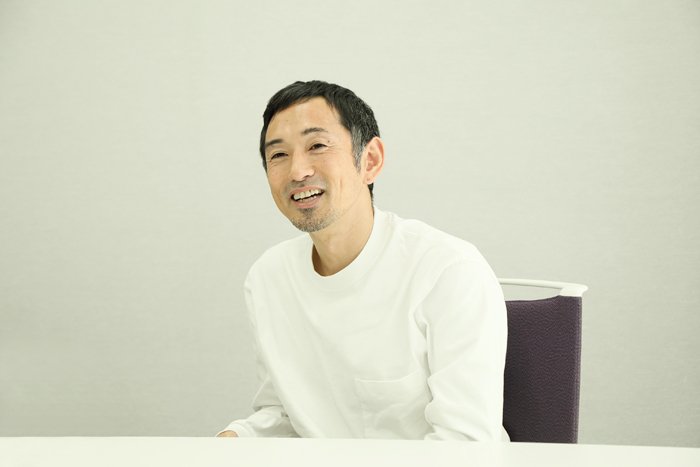A serial interview column where Mr. Dai Tamesue freely discusses "things on his mind right now." The only set theme is "What is autonomy? What is tolerance?" Mr. Tamesue shares his thoughts on various "things on his mind" in response to the mysterious "interviewer's" unexpected prompts. Well then. What kind of stories will come out this time...? Stay tuned.
──Continuing from last time, we'll once again explore the strange theme set by the editorial department: "What is transparency?"
Tamura: Thank you for having me.
──At the end of last time, you pointed out that the "transparency" athletes seek is, simply put, "moving smoothly, not jerkily." We'd like to start from there this time.
Tamemasu: I think the "transparency" athletes seek relates to both mind and body. Regarding the mind, it's what you might call a state of mindfulness. In my case, it's about discarding distracting thoughts and focusing all my nerves solely on the hurdle looming right in front of me.
──I understand. It might sound presumptuous, but I can imagine it.
Tamesue: The difficult part is achieving "transparency" in the body. It's about flowing smoothly and settling exactly where it should, I suppose. Athletes are constantly pursuing this sensation. You know how there are computer analyses of movement using pointers?
──Ah, where you attach points all over the body to study its movements?
Tamesue: Exactly. I tried various things during my active career, but ultimately, the truly important points are just about ten places on the human body: the hands, feet, elbows, head, hips, and ribcage. Just by recreating these points, somehow you can tell, "Ah, that's Tamesue's running style," or "That's that batter's swing form." You can even grasp the refinement of the movement.
──I can't feel it physically at all, but as a regular TV viewer, I understand perfectly. Like, "That's that pitcher's signature slider," or "He used his characteristic bat control to send it into the right-field stands," or "What a beautiful triple axel." I don't understand the technical details, but I sense a kind of "transparency" there.
Tamura: I believe top-tier athletes reach that level in any sport. Their movements are effortless, not jerky, always smooth.
──In sports like gymnastics or figure skating, that "smoothness" is precisely what they compete for. But even in sports where you're competing for fractions of a second, or where the goal is simply to overpower your opponent, you feel a sense of "smoothness" or "grace" in athletes or teams who have reached the pinnacle.
Tametsu: Mentally speaking, there's zazen meditation, right? I read in a book that they attached EEG monitors to two monks—one newly ordained and one veteran—and had them meditate. Then, suddenly, they played a loud, bell-like sound from behind. Both monks' brainwaves reacted identically—they were startled. But here's the interesting part: compared to the novice monk, the veteran monk's brainwaves quickly returned to normal.
──That's truly a "transparent state of mind." You could also call it a "state of nothingness."
Tametsu: People inevitably react reflexively to sudden accidents. I think what's crucial is being able to quickly regain your composure. I'm not sure if this explains "transparency," but it's not about being unshaken; it's about not staying shaken.
──I see. This is the first time I've heard a quantitative analysis of this "transparency."
Tamesue: I think athletes, politicians, and business leaders face the same challenge. The key is how to quantitatively analyze what's generally considered "qualitative." Otherwise, things everyone agrees are important end up being dismissed as mere mental attitude.
──In your specialty, track and field hurdles, that kind of meticulous pursuit manifests in fractions of a second, right?
Tamesue: The "smoothness" athletes pursue means eliminating vertical body movement and minimizing limb motion.
──Huh? That's surprising. Based on the image of track athletes, I'd think it's more about maximizing stride length or swinging your arms dynamically.
Tametsu: Of course, when you first start training, you swing your arms as hard as you can and push your legs forward aggressively. But intense movement means intense reversals too. It's like a car going at breakneck speed slamming on the brakes and then reversing at full throttle. So, as the movement becomes more refined, this element of reversal diminishes, making it smoother. Your arms and legs start to move in a circular pattern.
── I get it, or at least I think I do (laugh). That "smooth" and "supple" movement, as if manipulating air, makes us amateurs feel a certain "transparency," right? It's the same in track and field, judo, sumo, soccer, everything. The more elite the athlete, the more effortlessly they evade an opponent, effortlessly throw someone, effortlessly score a goal.
Tamese: I think the underlying principle is the same for politics and corporate management too. When you multiply that by a uniquely Japanese "spirituality," I believe it creates that impression of transparency, transparency, and clarity.
──Deep. There's so much more I want to hear about this. (Continued in #23)
(Interviewer: Web Dentsu Inc. News Editorial Department)
From the Athlete Brains Production Team (Hibi)
Part 2 of "Transparency." The "transparency" athletes seek has two aspects: "mental transparency" and "physical transparency." Mental transparency means being completely focused, thinking of nothing but the competition. Physical transparency, on the other hand, refers to small, smooth, and supple movements. The interviewer from the editorial department remarked, "This is deep," and indeed, this conversation is profound. I strongly feel we should soon have an opportunity to consider "What is a deep discussion? Why is it deep?" Every regular discussion with Mr. Tamesue brings new, fascinating insights. A high vantage point and deep contemplation. One of the things underpinning these is "transparency."
Athlete Brains Production Team Dentsu Inc. / Akinori Hibi (3CRP) · Genta Arahori (Late Bureau)
"Athlete Brains," centered around Mr. Dai Tamesue.
For details on this team that connects the knowledge cultivated by athletes to solving challenges in the world (businesses and society), please see here.












